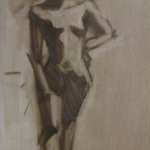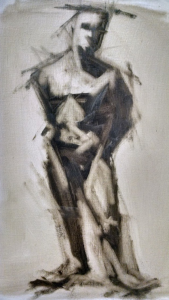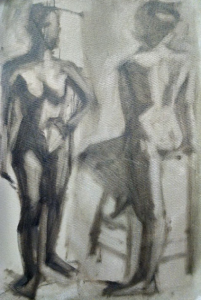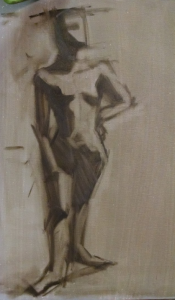Learning to keep it simple

 As an aspiring figure painter and student at Studio Incamminati in Philadelphia, PA for the past year and 1/2, I have probably sketched and painted the beautiful human figure hundreds if not thousands of times. During my first year of school, I was working in charcoal 6 hours a day, 5 days a week.
As an aspiring figure painter and student at Studio Incamminati in Philadelphia, PA for the past year and 1/2, I have probably sketched and painted the beautiful human figure hundreds if not thousands of times. During my first year of school, I was working in charcoal 6 hours a day, 5 days a week.
This year, as a lucky “Level 2” student, studies have moved from charcoal to paint. So, as I work in this new medium, I confess there is a bit of a feeling of, yet again, being a total “noob” (newbie) at something. Good grief this can be overwhelming sometimes! At this stage in life, one would normally expect to be proficient in a profession and even gaining recognition for that work. Call it dumb luck or ignorance or unfettered bliss but I cannot express how much I love learning this new skill. This is some of the hardest work I have ever done in my life and yet I can’t tell you how much I love it.
The fundamental principles we are learning are:
1. Find large simple shapes first
2. Use straight lines and angles
3. Push the gesture
4. Keep an eye on proportions
5. Use the least amount of materials and information to accurately represent what I see
6. After blocking in the initial gesture, step back and squint to help to simplify the complex figure into abstract shapes and forms
7. Look for anatomical references including the top of the head and the bottom of the feet, the midline, the sternum, clavicles, and pubic symphysis (halfway point).
 The beginning phase of this process takes my head into a space that I find difficult to describe but if I could experience that space on demand and package it up so I could share it with you I would. It is a transformative and transcendent place where I only see the model before me and the easel between the model and me. No matter what distractions I encounter (barking dogs in nearby apartments in the school building, sirens from ambulances or voices of monitors in nearby studios saying, “Model’s posing” which is a way to call classmates back to their easels after a break and ask the model to return to the model stand), I am not feeling my physical body in this moment in time.
The beginning phase of this process takes my head into a space that I find difficult to describe but if I could experience that space on demand and package it up so I could share it with you I would. It is a transformative and transcendent place where I only see the model before me and the easel between the model and me. No matter what distractions I encounter (barking dogs in nearby apartments in the school building, sirens from ambulances or voices of monitors in nearby studios saying, “Model’s posing” which is a way to call classmates back to their easels after a break and ask the model to return to the model stand), I am not feeling my physical body in this moment in time.
As I step back to gauge the accuracy of the gesture and proportions of the first lines I paint, I attempt to switch to a more analytical side of my mind to assess the work that I have done. This stage is the most difficult for me because I tend to ‘shoot from the hip’ and not take the time to critically assess what needs to be corrected. Several different instructors have told me to use the model’s anatomical landmarks to navigate this phase just as ancient mariners used constellations to navigate the sea. With time and practice, and a bamboo stick and marking the half way point on the canvas, I am slowly training my hand to paint what my eye is seeing. I have also started to look at people I pass on the street and make a mental note of their anatomical landmarks, just for fun!
At this stage of learning, I am only spending two 20 minute sessions with each painting. Then we wipe out our work and begin a new pose and painting. This helps me lose the affinity I might be developing for a particular painting and it also is helping me refine my skills with a healthy dose of skepticism when assessing my work. Thankfully, I have incredible teachers swooping in to keep me on task by saying things like, “Keep it simple” or asking me the most basic questions such as, “What are you doing?” If I get that question in the beginning phase of the painting, there’s no telling how long it takes me to switch back into reality to be able to answer that question. So in that moment, I may answer by saying, “What do you think I need to be doing?” Typically, I got some solid advice to clean up the contour lines and shadow shapes. Then I try to go back into the task of painting what I see.
 This week I had a moment of real clarity on something very, very fundamental. There is no doubt in my mind that stepping back and squinting helps me see simpler shapes on the model. In the past, however, I have stepped back, squinted and then stepped back up to the easel, looked at the model again in front of the easel and painted. I changed this process ever so slightly this week by making the decision (after receiving advice from a Teaching Fellow) to step back, squint and use what I see from that point of view to make a mark on my canvas. Whoa! This is hard to do because I am very tempted to peak at the model one more time once I am within painting distance of the easel. But what I found was that my ability to see errors more clearly improved. And, even though it initially seemed ‘slow’ to step back, squint, step forward and make a mark, it seemed that the marks I was making were much more accurate than in the past (as demonstrated by the study in this paragraph).
This week I had a moment of real clarity on something very, very fundamental. There is no doubt in my mind that stepping back and squinting helps me see simpler shapes on the model. In the past, however, I have stepped back, squinted and then stepped back up to the easel, looked at the model again in front of the easel and painted. I changed this process ever so slightly this week by making the decision (after receiving advice from a Teaching Fellow) to step back, squint and use what I see from that point of view to make a mark on my canvas. Whoa! This is hard to do because I am very tempted to peak at the model one more time once I am within painting distance of the easel. But what I found was that my ability to see errors more clearly improved. And, even though it initially seemed ‘slow’ to step back, squint, step forward and make a mark, it seemed that the marks I was making were much more accurate than in the past (as demonstrated by the study in this paragraph).
Stay tuned as I continue to see how to keep it simple in this amazing journey of learning to paint the unique and beautiful human figure!

8 Comments
Annie Nashold
October 25, 2015Julie
Sounds like the brain is working and the hand is learning! Wow, love your descriptive thought process. Thanks for sharing!
Julie Holmes
October 25, 2015Hi Annie, Yes, the brain is working and, on some days, the hand listens. Ha! It’s great to hear from you and I look forward to seeing your latest artistic creations!
Jim Dyer
October 25, 2015Julie – thx for sharing. Nicely articulated. Will change the way I look at paintings, too.
Maybe we can catch the Rembrandt and Vermeer show at the MFA when you are here and you can coach me thru……
Julie Holmes
October 25, 2015Hi Jim! You bet. I would love to catch the Rembrandt and Vermeer show with you at the MFA! Stay tuned and thx for reading!
Ruth Whitney
October 26, 2015Hi Julie,
Your description of process makes compelling reading. It seems so similar to what athletes describe as being in the zone.
I also loved your description of seeing people on the street differently. We’re gearing up to sponsor the writing craziness of National Novel Writing Month. One of the things I say to faculty who pooh-pooh the program is that it often helps writers see the “bones” or the structure of the stories they read in a new light because they tried to write a story and create that structure themselves. It sounds as if you’re doing a similar process of trying to see the structure and simple forms to paint – in a much more academic way, of course.
Keep us along for they journey with your posts.
Ruth
Julie Holmes
October 26, 2015Hi Ruth!
Yes – I can see the similarity in your reference to writers doing NNWM to encourage seeing structure. It sounds so easy and is,ironically, so difficult.
Wondering if you’ll be able to write in November amidst the mayhem of life at the moment?
Thank you for chiming in and reading about the journey!
Beth Clary
October 27, 2015Fabulous description of your zone, Julie! Love the whole “feel” of the post. A published writer once said to me that he spends most days trying to get back to that zone he’s been in when writing goes well. WHat I love about this post and your program is that it sounds as if they’re training and teaching you how to do that. Very cool! Thanks for sharing.
P.S. I remember going to Swan Lake with the kids one time, each of us with a sketchbook and colored pencils. There were baby swans and we sat on the sidewalk and attempted drawing them. That was the first time I’d ever noticed the “extra” ring around a swan’s eyes. Rocked my world. Can’t imagine having that every day!
Julie Holmes
October 27, 2015Hi Beth,
Wow – glad you were able to sense the totally difficult (for me) to describe space that my head enters when drawing! Given your comment about the writer, this seems to be a welcome by product of the creative process in writing, too.
This is also a means of ‘untraining’ what my brain thinks I see and starting to let my eyes and hands create what’s right in front of me. More than one teacher has said to step back, squint and even imagine an ‘ant’ crawling along the form I’m drawing. Ha! That ant doesn’t ‘lie’ – it will, hopefully, lead me to see the still life or figure in front of me. In the same way that you and the kids saw that ring around the swan’s eyes.
Stay tuned and thank you for reading!